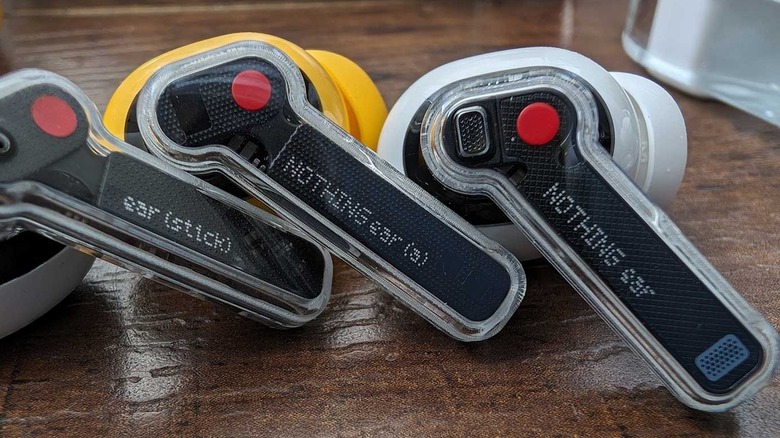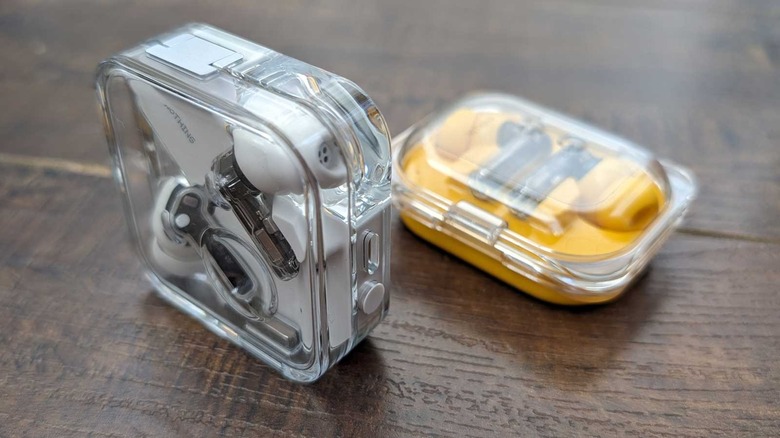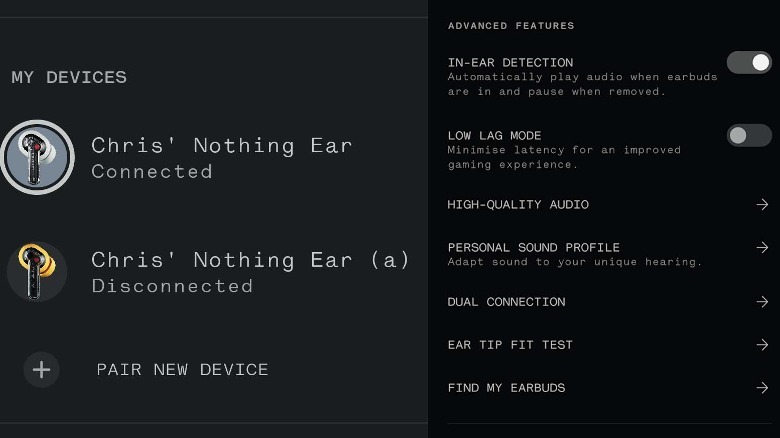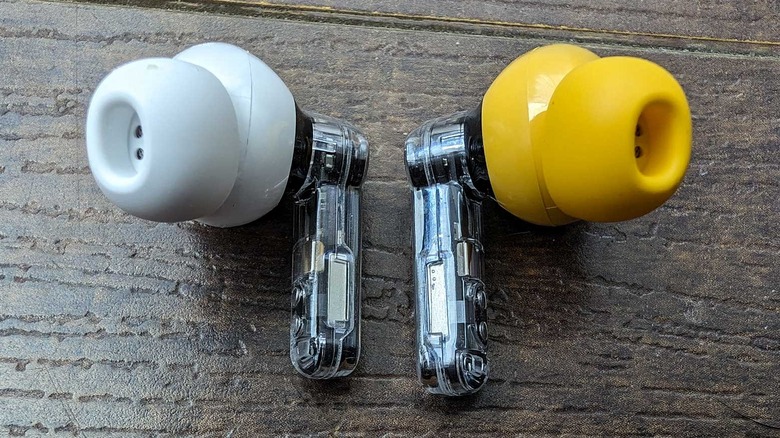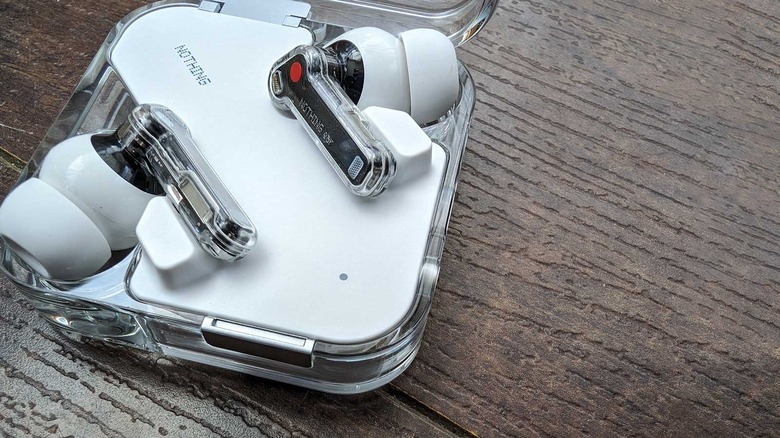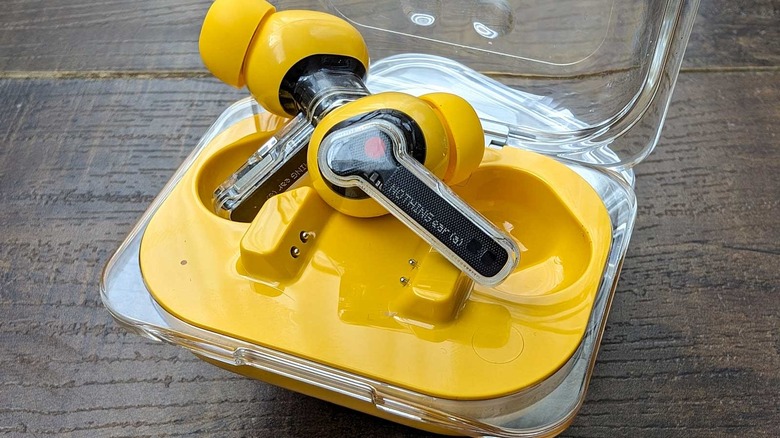Nothing Ear (A) Vs Ear (2024): What's The Difference, And Which ANC Earbuds Are Best?
Nothing released two new sets of earbuds in April of 2024, one with the same name as its predecessor, the other with an (a) attached. Nothing now has several sets of earbuds out in the world — all of them look unique (among the rest of the earbuds in the world not made by Nothing). All of them have the word "Ear" in their title. From that point, it all gets quite confusing — but we're here to clear things up, a bit.
First, there was the Nothing Ear (1) back in 2021. Then came the Nothing Ear (Stick) — a pair of earbuds with a similar set of features as well as a unique — however real-world-use flawed — case design. Then came the Nothing Ear (2) in 2023. Now we're looking at two pairs of earbuds that are set to ship in late April and early May of 2024. One is called Nothing Ear, the other is called Nothing Ear (a). So, as they're released in order, the devices are: Nothing Ear (1), Nothing Ear (Stick), Nothing Ear (2), and Nothing Ear (as well as Nothing Ear (a)). The latest pair of devices were provided to SlashGear for testing for this article.
Price Structure and Touch Controls
Nothing Ear (1) originally cost $99 when they were launched in 2021. In October 2022, the price of Nothing Ear (1) was raised to $149 due to "an increase in costs" — so said Nothing CEO's Carl Pei. In November 2022, Nothing Ear (Stick) earbuds were released for $99. Nothing Ear (2) launched in 2023 for $149, and in 2023 we have both the Nothing Ear and Nothing Ear (a) released in late April 2024 for $149 and $99 respectively.
The eternal design of these devices has stayed largely the same. You could easily mistake one of these buds for the other — except for the yellow version of Nothing Ear (a) which is, as yet, the only departure the line of earbuds has taken from black and white.
We're still working with the "Pinch" model we were with the Nothing Ear (2), which is a bit of a bummer. Not that it doesn't work — it works just fine — but we'll still miss the "swipe to adjust volume" system of the first generation. Now each bud can be programmed to double pinch and hold to adjust volume, which is an OK replacement for what's gone.
What's the difference?
Dynamic Driver materials in each generation of Nothing Ear have changed significantly — sort of. Maybe more in name than in practice. The Nothing Ear (1) generation worked with Graphene, (2) with Graphene + PU, and now in 2024 it's all changed again — Nothing Ear (a) works with PMI + TPU while Nothing Ear has ceramic inside. This should, in theory, mean that Ear (2024) earbuds have a more professional sound — ceramic vs PMI and TPU, but really, the difference in practice has been negligible.
The only audio tech difference (beyond the materials) between the Ear and Ear (a) is the inclusion of LHDC 5.0 in the Ear — and not in the Ear (a). If you have one of the few audio-transmitting devices in the world released with LDC 5.0 right now, this might be a dealbreaker — otherwise, it's completely superfluous.
The more important codec here is LDAC. Nothing Ear (1) had LDAC, Nothing Ear (2) did not, and Nothing Ear (2024) and Nothing Ear (a) both have LDAC once again. If you're using an Android phone, chances are you have a device that supports LDAC (and SBC and AAC). If you have an iPhone, you do not have LDAC or LHDC at all — you just have AAC.
Nothing Ear (2) had ANC (active noise cancellation) up to 40 dB, and both Nothing Ear (2024) and Nothing Ear (a) now have ANC up to 45 dB.
With a Google Pixel 8 Pro, these earbuds sound noticeably better than their predecessors but not all that different from one another. With an iPhone 15, these earbuds sound pretty much the same as Nothing Ear (2).
Battery Case, Size, Weight
The battery case for the Nothing Ear (2024) is more impressive than that of the (a). The Ear case has IP55 dust and water ingress protection (dust protected, water jet protection — higher than spraying, less than immersion) while the (a) case only has IPX2 (no protection vs dust, water protection limited to dripping water).
On the other hand, both earbuds (the buds, not the cases) have the same IP54 rating — dust-protected, splashing water-protected. Buds have the same ruggedness, but the case on the (a) is ever-so-slightly less protective than the Ear (2024).
The most major change between the cases is in wireless charging. You can charge up to 2.5W with the Ear earbuds in their case, while the (a) buds in their case are limited to USB-C. Both cases can charge with USB-C quite speedily — Nothing suggests that 10 minutes of charge will give the buds 10 hours of playtime.
Both buds last longer than their predecessors — the Buds (2)'s "up to 36 hours" is ramped up to 40.5 hours for the Ear (2024) and 42.5 hours for the (a). On that note — playback (without ANC) is quoted at 8.5 hours for the Ear and 9.5 hours for the (a) (both including the charge case's internal battery, which is 500mAh for both models). Our testing suggests that both the Ear and the Ear (a) last approximately 7-8 hours — that's counting the battery in the earbuds and a fully charged battery in the case for reloading.
Wrap-up and verdict
Both the Nothing Ear (2024) and the Nothing Ear (a) are worth what they cost, but unless you're looking specifically for LHDC 5.0 compatibility or you absolutely cannot live without wireless charging in your earbuds charging case, Nothing Ear (a) is the best deal of the two. At $99, Nothing Ear (a) might very well be the best price-for-quality ANC earbuds on the market today.
You can purchase Nothing Ear (a) from the Nothing store right now for approximately $99. The 2024 version of Nothing Ear at the Nothing store will cost you right around $149. If you have an iPhone, you might still want to look to the Beats Studio Buds+ – at this $150 price point, it'll mostly come down to which transparent plastic you like best, and whether you're able to find a super sale on any of these options.
